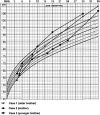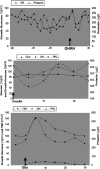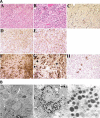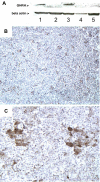Hereditary pituitary hyperplasia with infantile gigantism
- PMID: 21976722
- PMCID: PMC3232621
- DOI: 10.1210/jc.2011-1401
Hereditary pituitary hyperplasia with infantile gigantism
Abstract
Context: We report hereditary pituitary hyperplasia.
Objective: The objective of the study was to describe the results of the clinical and laboratory analysis of this rare instance of hereditary pituitary hyperplasia.
Design: The study is a retrospective analysis of three cases from one family.
Setting: The study was conducted at the National Institutes of Health, a tertiary referral center.
Patients: A mother and both her sons had very early-onset gigantism associated with high levels of serum GH and prolactin.
Interventions: The condition was treated by total hypophysectomy.
Main outcome measure(s): We performed clinical, pathological, and molecular evaluations, including evaluation basal and provocative endocrine testing, neuroradiological assessment, and assessment of the pituitary tissue by microscopic evaluation, immunohistochemistry, and electron microscopy.
Results: All three family members had very early onset of gigantism associated with abnormally high serum levels of GH and prolactin. Serum GHRH levels were not elevated in either of the boys. The clinical, radiographic, surgical, and histological findings indicated mammosomatotroph hyperplasia. The pituitary gland of both boys revealed diffuse mammosomatotroph hyperplasia of the entire pituitary gland without evidence of adenoma. Prolactin and GH were secreted by the same cells within the same secretory granules. Western blot and immunohistochemistry demonstrated expression of GHRH in clusters of cells distributed throughout the hyperplastic pituitary of both boys.
Conclusions: This hereditary condition seems to be a result of embryonic pituitary maldevelopment with retention and expansion of the mammosomatotrophs. The findings suggest that it is caused by paracrine or autocrine pituitary GHRH secretion during pituitary development.
Figures






Similar articles
-
Congenital gigantism due to growth hormone-releasing hormone excess and pituitary hyperplasia with adenomatous transformation.J Clin Endocrinol Metab. 1993 Jan;76(1):216-22. doi: 10.1210/jcem.76.1.8421089. J Clin Endocrinol Metab. 1993. PMID: 8421089
-
Mammosomatotroph adenoma cells secrete both growth hormone and prolactin.Neurol Med Chir (Tokyo). 1995 Nov;35(11):791-6. doi: 10.2176/nmc.35.791. Neurol Med Chir (Tokyo). 1995. PMID: 8657329
-
A growth hormone-releasing hormone-producing pancreatic islet cell tumor metastasized to the pituitary is associated with pituitary somatotroph hyperplasia and acromegaly.J Clin Endocrinol Metab. 1997 Aug;82(8):2731-7. doi: 10.1210/jcem.82.8.4175. J Clin Endocrinol Metab. 1997. PMID: 9253362
-
A child with pituitary gigantism and precocious adrenarche: does GH and/or PRL advance the onset of adrenarche?Endocrinol Jpn. 1992 Jun;39(3):251-7. doi: 10.1507/endocrj1954.39.251. Endocrinol Jpn. 1992. PMID: 1425451 Review.
-
Pathology of acromegaly.Neuroendocrinology. 2006;83(3-4):161-5. doi: 10.1159/000095524. Epub 2006 Oct 13. Neuroendocrinology. 2006. PMID: 17047379 Review.
Cited by
-
Pituitary gigantism: update on molecular biology and management.Curr Opin Endocrinol Diabetes Obes. 2016 Feb;23(1):72-80. doi: 10.1097/MED.0000000000000212. Curr Opin Endocrinol Diabetes Obes. 2016. PMID: 26574647 Free PMC article. Review.
-
Genetics of Acromegaly and Gigantism.J Clin Med. 2021 Mar 29;10(7):1377. doi: 10.3390/jcm10071377. J Clin Med. 2021. PMID: 33805450 Free PMC article. Review.
-
Is IGSF1 involved in human pituitary tumor formation?Endocr Relat Cancer. 2015 Feb;22(1):47-54. doi: 10.1530/ERC-14-0465. Epub 2014 Dec 19. Endocr Relat Cancer. 2015. PMID: 25527509 Free PMC article.
-
Somatic GNAS mutation causes widespread and diffuse pituitary disease in acromegalic patients with McCune-Albright syndrome.J Clin Endocrinol Metab. 2012 Jul;97(7):2404-13. doi: 10.1210/jc.2012-1274. Epub 2012 May 7. J Clin Endocrinol Metab. 2012. PMID: 22564667 Free PMC article.
-
Gigantism and acromegaly due to Xq26 microduplications and GPR101 mutation.N Engl J Med. 2014 Dec 18;371(25):2363-74. doi: 10.1056/NEJMoa1408028. Epub 2014 Dec 3. N Engl J Med. 2014. PMID: 25470569 Free PMC article.
References
-
- Mayo KE, Hammer RE, Swanson LW, Brinster RL, Rosenfeld MG, Evans RM. 1988. Dramatic pituitary hyperplasia in transgenic mice expressing a human growth hormone-releasing factor gene. Mol Endocrinol 2:606–612 - PubMed
-
- Asa SL, Kovacs K, Stefaneanu L, Horvath E, Billestrup N, Gonzalez-Manchon C, Vale W. 1990. Pituitary mammosomatotroph adenomas develop in old mice transgenic for growth hormone-releasing hormone. Proc Soc Exp Biol Med 193:232–235 - PubMed
-
- Espiner EA, Carter TA, Abbott GD, Wrightson P. 1981. Pituitary gigantism in a 31 month old girl: endocrine studies and successful response to hypophysectomy. J Endocrinol Invest 4:445–450 - PubMed
Publication types
MeSH terms
Substances
Grants and funding
LinkOut - more resources
Full Text Sources
Other Literature Sources

